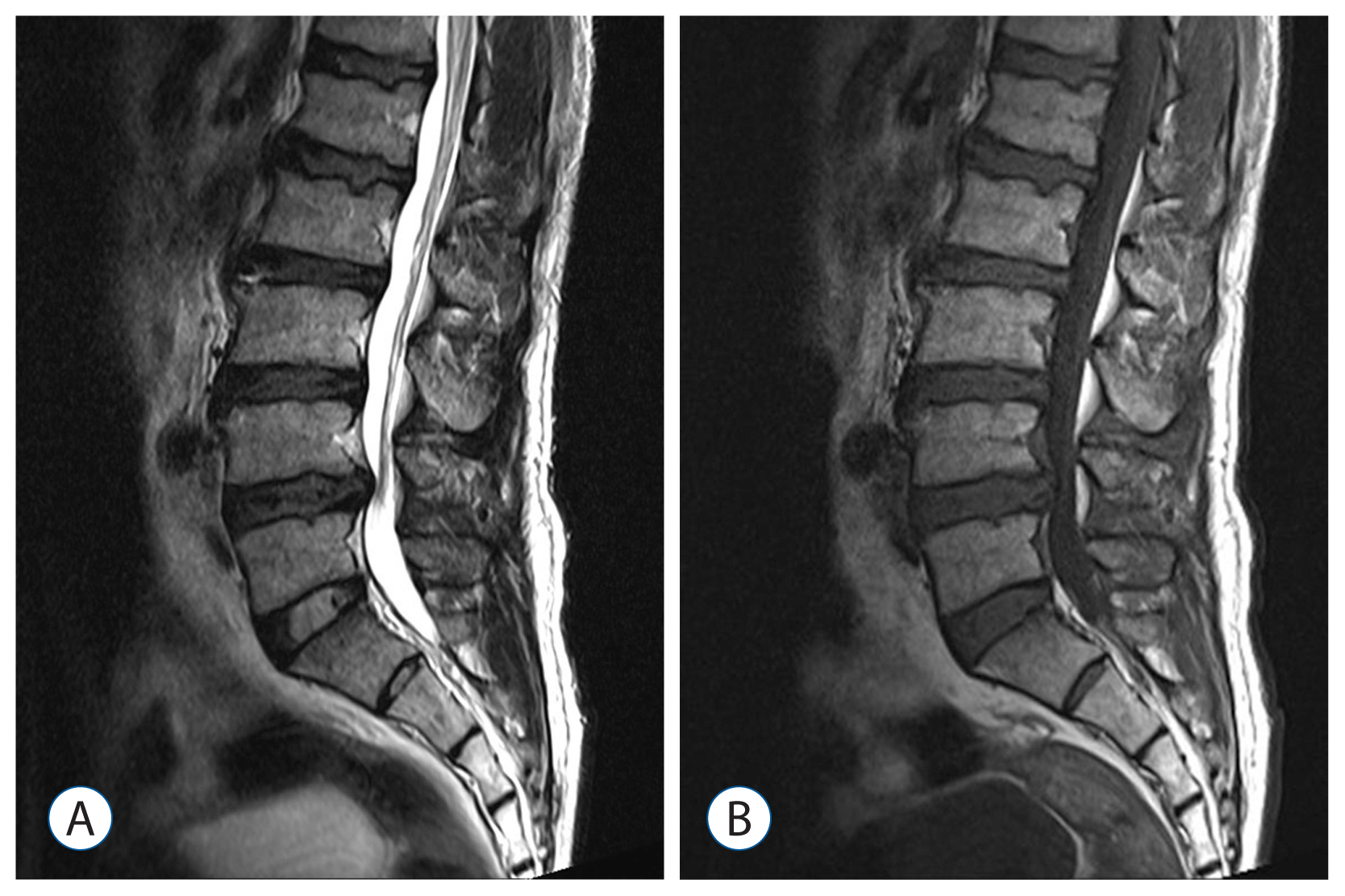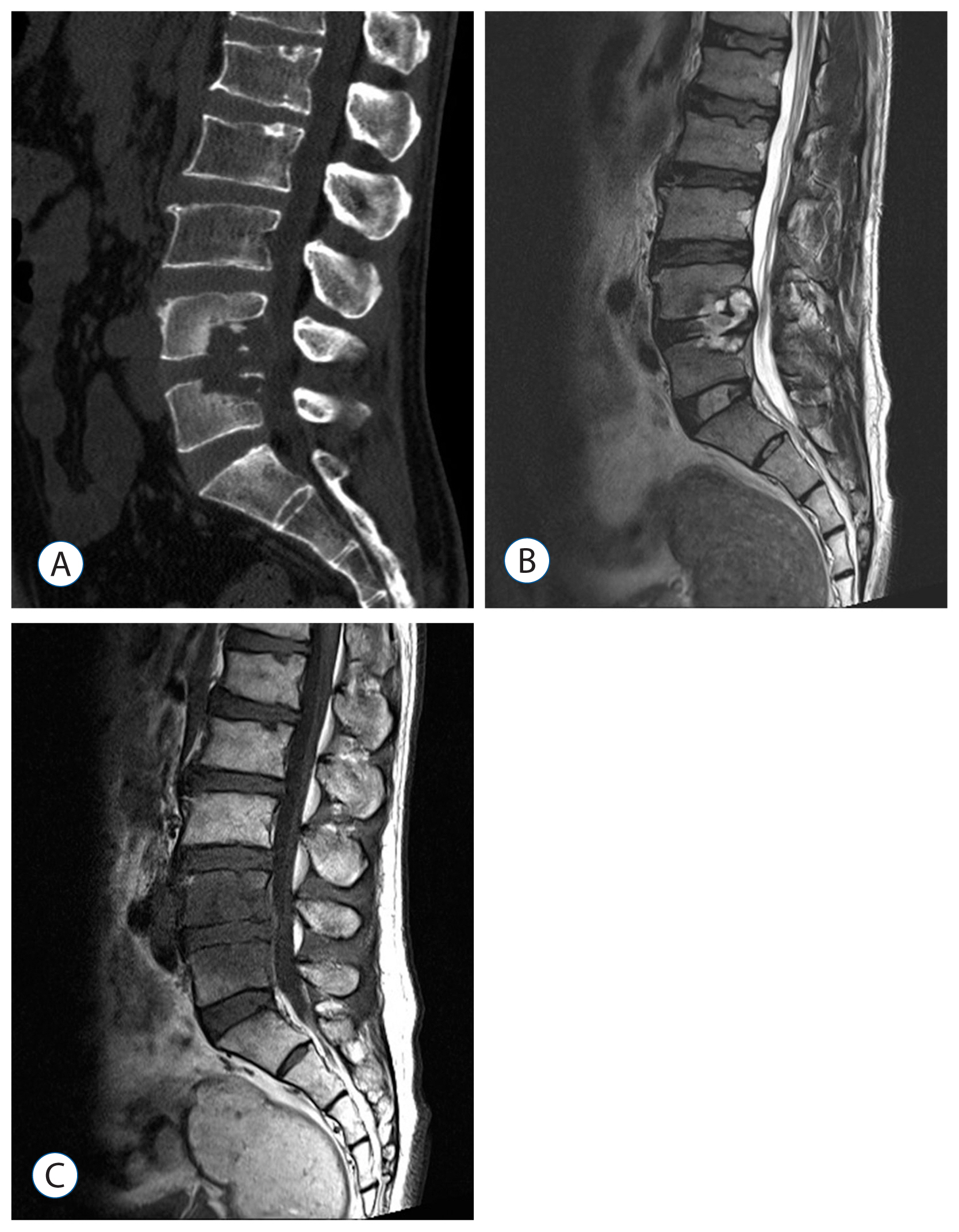J Korean Neurosurg Soc.
2017 Jan;60(1):114-117. 10.3340/jkns.2014.1011.019.
Thermal-Induced Osteonecrosis of Adjacent Vertebra after Intradiscal Electrothermal Therapy
- Affiliations
-
- 1Department of Neurosurgery, Spine Center, Samsung Medical Center Sungkyunkwan University, School of Medicine, Seoul, Korea. sobotta72@hotmail.com
- 2College of Medicine, Seonam University, Namwon, Korea.
- KMID: 2365597
- DOI: http://doi.org/10.3340/jkns.2014.1011.019
Abstract
- A 42-year-old man was admitted to our hospital with complaints of low back pain and intermittent right thigh pain. Twelve weeks before admission, the patient received intradiscal electrothermal therapy (IDET) at a local hospital. The patient still reported low back pain after the procedure that was managed with narcotic analgesics. Follow-up magnetic resonance imaging (MRI) was performed, and his referring physician thought the likely diagnosis was spondylodiscitis at the L4-5 spinal segment with a small epidural abscess. At admission to our department, the patient reported aggravated low back pain. Blood test results, including the erythrocyte sedimentation rate and C-reactive protein levels, were slightly elevated. Biopsy samples of the L4, L5 vertebral bodies and disk were obtained. The material underwent aerobic, anaerobic, fungal, mycobacterial cultures and histologic examination. Results of all cultures were negative. Histologically, necrosis of the bone was evident from the number of empty osteocyte lacunae. In addition, there was no evidence of infection based on biopsy results. No antibiotic treatment was administered on discharge. Repeat computed tomography and MRI performed 12 months after IDET showed a bony defect in the L4 and L5 vertebral bodies, and a decrease in the size of the L4-5 intervertebral disc lesion. We report a case of lumbar vertebral osteonecrosis induced by IDET and discuss etiology and radiologic features.
MeSH Terms
Figure
Reference
-
References
1. Assietti R, Morosi M, Block J. Intradiscal electrothermal therapy for symptomatic internal disc disruption: 24-month results and predictors of clinical success. J Neurosurgery Spine. 12:320–326. 2010.
Article2. Berman AT, Reid JS, Yanicko DR Jr, Sih GC, Zimmerman MR. Thermally induced bone necrosis in rabbits: Relation to implant failure in humans. Clin Orthop Relat Res. (186):284–292. 1984.3. Biyani A, Andersson G, Chaudhary H, An H. Intradiscal electrothermal therapy: a treatment option in patients with internal disc disruption. Spine (Phila Pa 1976). 28(15 Suppl):S8–S14. 2003.4. Cohen S, Larkin T, Abdi S, Chang A, Stojanovic M. Risk Factors for Failure and Complications of Intradiscal Electrothermal Therapy: A Pilot Study. Spine (Phila Pa 1976). 28:1142–1147. 2003.
Article5. de Berg J, Pattynama P, Obermann W, Bode PJ, Vielvoye GJ, Taminiau AH. Percutaneous computed-tomography-guided thermocoagulation for osteoid osteomas. Lancet. 346:350–351. 1985.
Article6. Djurasovic M, Glassman SD, Dimar JR 2nd, Johnson JR. Vertebral osteonecrosis associated with the use of intradiscal electrothermal therapy: a case report. Spine (Phila Pa 1976). 27:E325–E328. 2002.7. Freeman BJ. IDET: a critical appraisal of the evidence. Eur Spine J. 15:448–457. 2006.
Article8. Heary RF. Intradiscal electrothermal annuloplasty: the IDET procedure. J Spinal Disord. 14:353–360. 2001.
Article9. Mjöberg B, Pettersson H, Rosenqvist R, Rydholm A. Bone cement, thermal injury, and the radiolucent zone. Acta Orthop Scand. 55:597–600. 1984.
Article10. Rock M, Capanna R. The treatment of giant cell tumor of bone. Stauffer R, Ehrlich M, Fu F, editors. Advances in Operative Orthopaedics. St. Louis, MO: Mosby-Year Book;1993. p. 367–390.11. Rosenthal DI, Alexander A, Rosenberg AE, Springfield D. Ablation of osteoid osteomas with a percutaneously placed electrode: a new procedure. Radiology. 183:29–33. 1992.
Article12. Saal JS, Saal JA. Management of chronic discogenic low back pain with a thermal intradiscal catheter. A preliminary report. Spine (Phila Pa 1976). 25:382–388. 2000.
Article13. Scholl BM, Theiss SM, Lopez-Ben R, Kraft M. Vertebral osteonecrosis related to intradiscal electrothermal therapy: a case report. Spine (Phila Pa 1976). 28:E161–E164. 2003.14. Tillotson CL, Rosenberg AE, Rosenthal DI. Controlled thermal injury of bone. Report of a percutaneous technique using radiofrequency electrode and generator. Invest Radiol. 24:888–892. 1989.
Article15. Türker M, Çetik Ö, Çırpar M, Durusoy S, Cömert B. Postarthroscopy osteonecrosis of the knee. Knee Surg Sports Traumatol Arthrosc. 23:246–250. 2015.
Article
- Full Text Links
- Actions
-
Cited
- CITED
-
- Close
- Share
- Similar articles
-
- Intradiscal Electrothermal Annuloplasty in Chronic Discogenic Low Back Pain
- Dysphagia after Cervical Intradiscal Electrothermal Therapy: A Case Report
- Full-endoscopic Intradiscal Surgery: State of the Art
- Results of Intradiscal Pulsed Radiofrequency for Lumbar Discogenic Pain: Comparison with Intradiscal Electrothermal Therapy
- Distinguishing CT and MR Imaging Features of Postprocedural Inflammation and Infectious Spondylodiscitis After Intradiscal Electrothermal Therapy




